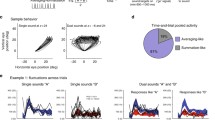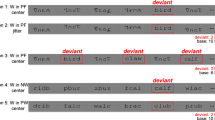We report here our studies of the neurophysiological mechanisms of the processing of verbal information of different types: 1) known target words; 2) known nontarget words; 3) unknown words. Evoked changes in rhythmic activity (ECRA) in the cerebral cortex during performance of a stimulus categorization task were analyzed. As compared with unknown words, known target stimuli produced a high level of synchronization of electrical activity in the θ1 and θ2 ranges at the early stage, 150–300 msec after stimulus presentation, and in the δ range at 400–700 msec after stimulus presentation. At later stages, at 800–1500 msec, target stimuli produced less synchronization of the θ1 rhythm than known nontarget and unknown words, along with greater desynchronization in the θ2 and α ranges than known nontarget stimuli.
Similar content being viewed by others
References
Allefeld, C. and Frisch, S., “Phase synchronization analysis of event-related potentials in language processing,” in: Experimental Chaos: 8th Experimental Chaos Conf., Boccaletti S. G. et al. (eds.) (2004).
Bachman, P., Kim, J., Yee, C. M., et al., “Abnormally high EEG alpha synchrony during working memory maintenance in twins discordant for schizophrenia,” Schizophr. Res., 103, No. 1–3, 293–297 (2008).
Bastiaansen, M. C. M. and Brunia, G. H., “Anticipatory attention; an eventrelated desynchronization approach,” Int. J. Psychophysiol., 43, 91–107 (2001).
Bastiaansen, M. C. M., van der Linden, M., ter Keurs, M., et al., “Theta responses are involved in lexical-semantic retrieval during language processing,” J. Cogn. Neurosci., 17, No. 3, 530–541 05
Bastiaansen, M. C. M., Magyari, L., and Hagoort, P., “Syntactic unification operations are reflected in oscillatory dynamics during on-line sentence comprehension,” J. Cogn. Neurosci., 22, 1333–1347 (2010).
Bastiaansen, M. C. M., Oostenveld, R., Jensen O., and Hagoort, P., “I see what you mean: Theta power increases are involved in the retrieval of lexical semantic information,” Brain Lang., 106, No. 1, 15–28 (2008).
Braunstein, V., Ischebeck, A., Brunner, C., et al., “Investigating the influence of proficiency on semantic processing in bilinguals: An ERP and ERD/S analysis,” Acta Neurobiol. Exp., 72, 4221–438 (2012).
Bruns, A. and Eckhorm, R., “Task-related coupling from high-to low-frequency signals among visual cortical areas in human subdural recordings,” Int. J. Psychophysiol., 51, 97–116 (2004).
Cohen, L., Lehericy, S., Chochon, F., et al., “Language-specific tuning of visual cortex? Functional properties of the visual word form area,” Brain, 125, 1054–1069 (2002).
Karrasch, M., Krause, C. M., Laine, M., et al., “Event-related desynchronization and synchronization during an auditory lexical matching task,” EEG Neurophysiol., 107, 112–121 (1998).
Klimesch, W., Doppelmayr, M., Schimke, H., and Ripper, B., “Theta synchronization and alpha desynchronization in a memory task,” Psychophysiology, 34, No. 2, 169–176 (1997).
Klimesch, W., “EEG alpha and theta oscillations reflect cognitive and memory performance: A review and analysis,” Bran Res. Rev., 29, 169–195 (1999).
Klimesch, W., Doppelmayr, M., Pachinger, H., and Russegger H., “Eventrelated desynchronization in the alpha band and the processing of semantic information,” Cogn. Brain Res., 6, 83–94 (1997).
Klimesch, W., Doppelmayr, M., Schwaiger, J., et al., “Theta oscillations and ERP old/new effect: independent phenomena?” Clin. Neurophysiol., 11, 781–793 (2000).
Klimesch, W., Sauseng, P., and Hanslmayr S., “EEG alpha oscillations: The inhibition-timing hypothesis,” Brain Res. Rev., 53, 63–88 (2007).
Klimesch, W., Schimke, H., and Schwaiger, J., “Episodic and semantic memory: an analysis in the EEG theta and alpha band,” EEG Clin. Neurophysiol., 91, 428–441 (1994).
Krause, C. M., Grönholm, P., Leinonen, A., et al., “Modality matters: the effects of stimulus modality on the 4- to 30-Hz brain electric oscillations during a lexical decision task,” Brain Res., 1110, No. 1, 182–192 (2006).
Krause, C. M., Sillanmäki, L., Koivisto, et al., “The effects of memory load on event-related EEG desynchronization and synchronization,” Clin. Neurophysiol., 111, No. 11, 2071–2078 (2000).
Maguire, M. J., Brier, M. R., and Ferree, T. C., “EEG theta and alpha responses reveal qualitative differences in processing taxonomic versus thematic semantic relationships,” Brain Lang., 114, No. 1, 16–25 (2010).
Mellem, M. C., Friedman, R. B., and Medvedev, A. V., “Gamma-and theta-band synchronization during semantic priming reflect local and long-range lexical-semantic networks,” Brain Lang., 127, No. 3, 440–451 (2013).
Neubauer, A. C., Fink, A., and Grabner, R. H., “Sensitivity of alpha band ERD to individual differences in cognition,” Prog. Brain Res., 159, 167–178 (2006).
Pesonen, M., Hämäläinen H., and Krause C. M., “Brain oscillatory 4–30 Hz responses during a visual n-back memory task with varying memory load,” Brain Res., 1138, 171–177 (2007).
Pfurtscheller, G. and Lopes da Silva, F. N., “Event-related EEG-MEG synchronization and desynchronization: Basic principles,” Clin. Neurophysiol., 110, 1842–1857 (1999).
Pulvermüller, F., Shtyrov, Y., and Hauk, O., “Understanding in an instant: neurophysiological evidence for mechanistic language circuits in the brain,” Brain Lang., 110, 81–94 (2009).
Rebreikina, A. B., Novototskii-Vlasov, V. Yu., and Strelets, V. B., “Reflection of the processing of visually presented verbal stimuli in evoked potentials,” Zh. Vyssh. Nerv. Deyat., 58, No. 3, 294–301 (2008).
Roehm, D., Schlesewsky, M., Frish, S., and Haider, H., “Fractionating language comprehension via frequency characteristics of the human EEG,” Neuroreport, 15, 409–412 (2004).
Sauseng, P. and Klimesch, W., “What does phase information of oscillatory brain activity tell us about cognitive processes?” Neurosci. Biobehav. Res., 32, 1001–1013 (2008).
Van Strien, J. V., Hagenbeek, R. E., Stam, C. J., et al., “Changes in brain electrical activity during extended continuous word recognition,” NeuroImage, 26, 952–959 (2005).
Author information
Authors and Affiliations
Corresponding author
Additional information
Translated from Zhurnal Vysshei Nervnoi Deyatel’nosti imeni I. P. Pavlova, Vol. 65, No. 1, pp. 92–104, January–February, 2015.
Rights and permissions
About this article
Cite this article
Rebreikina, A.B., Larionova, E.V. & Varlamov, A.A. Evoked Changes in the Rhythmic Activity of the Brain during Processing of Visually Presented Target, Nontarget, and Unknown Words. Neurosci Behav Physi 46, 494–503 (2016). https://doi.org/10.1007/s11055-016-0265-2
Received:
Accepted:
Published:
Issue Date:
DOI: https://doi.org/10.1007/s11055-016-0265-2




